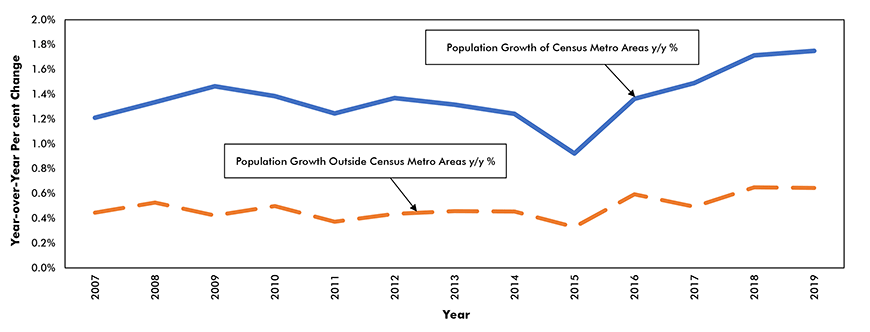Approaching the beginning of the third decade of the 21st century, Canada is urbanizing at an unprecedented rate. This observation is based on Statistics Canada’s recent release of the nation’s sub-provincial population estimates which reported that during the 12 months ending July 1, 2019, the population of Canada’s largest urban areas increased by 463,000 (1.75%). To put this growth rate in perspective, over the same period the population of the rest of the country increased by just 68,000 (0.6%). As noted in last year’s Snapshot #19, which focused on Canada’s total population as of July 1, 2019, almost all the population growth in Canada’s large urban centres was fuelled by permanent and temporary immigration.
The subprovincial population estimates highlight four significant aspects of the growth of Canada’s CMAs (Census Metro Areas with populations of more than 100,000) over the recent past.
Ontario has the fastest growing CMAs led by Kitchener-Cambridge-Waterloo
For the second consecutive year, Kitchener-Cambridge-Waterloo was the fastest-growing CMA in Canada. After posting growth of 2.6% in 2017-18, it saw its population growth accelerate to 2.8% in 2018/19. Next, London, Ontario posted growth of 2.3% in 2018/19 after a gain of 2.4% the previous year. It is worth noting that both Kitchener-Cambridge-Waterloo and London are home to major universities that serve as a magnet for individuals both inside and more importantly outside the country. The third fastest-growing city in 2018/19 was the Ontario portion of Ottawa/Gatineau which saw its population accelerate from 2.2% in 2017-18 to 2.3% in 2018/19.
Interactive Visual
Growth of baby boomers in Canada’s CMAs is still strong but gradually slowing
Over the past 75 years, the post-war baby boom has had a profound impact on all aspects of Canada’s social and economic fabric. While this demographic group is still the fastest growing in Canada’s major urban centres, the growth of individuals aged 55 to 75 has steadily slowed from 3.8% to 2.8% over the past nine years. Despite this gradual slowing, this age group continues to expand at an above-average rate of 3.0% in a third of the country’s 35 CMAs. Topping the list of the 12 CMAs which experienced the fastest growth of (now aging) baby boomers is Calgary, Alberta with a year-over-year increase of 4.4% in 2018/19. Barrie, Ontario saw growth of 4.3% followed by Saskatoon, Saskatchewan (+4.3%) and Oshawa, Ontario (+3.9%).
Millennials are making an increasing contribution to CMA growth
Approximately one in three (29%) of Canadians currently living in a CMA is a millennial (i.e. an individual aged 20 to 39). entering their prime working and spending year). Over the past 4 years, the growth rate of this age group accelerated from 0.4% to a record 2.5% in 2018/19. Consistent with the fact that it is one of Canada’s premier tech hubs, the millennial age group in Kitchener-Cambridge-Waterloo increased by 6.0% in 2018/19 after posting a gain of 4.7% in 2017/18. In Windsor, the number of millennials rose by 4.4% accounting for two-thirds of the CMA’s population growth in 2018/19.
Other CMA’s which have experienced above-average growth in the number of millennials include Abbotsford-Mission, British Columbia (+4.0%), London, Ontario (+3.7%), Toronto, Ontario (+3.7%) and Halifax, Nova Scotia (+3.6%). Since they are younger, it is not surprising that the rising concentration of millennials has lowered the median age of Canada’s CMAs, currently 39.5 yrs, relative to the rest of country (45.7 yrs).
Suburban population growth particularly strong close to the Toronto CMA
The one final development revealed by the latest population estimates is the evidence of accelerating urban spread — some might say sprawl. This phenomenon is very pronounced in the area on the outskirts of Toronto. Whereas Toronto CMA saw its population increase by 2% in each of the past two years, the municipality of East Gwillimbury to the north saw population growth of 10% in 2018/19 after posting a gain of 12% in 2017/18. To the west, the population of Milton increased by 5.1%, followed by Brampton (+4.7%) and Shelburne (+4%). Given the federal government’s plan to admit 340,000 immigrants to Canada in 2020 and since Toronto attracts approximately a third of international migrants, it appears likely that population growth in the municipalities on the edge of Toronto will continue to outpace the whole CMA for the next several years.
Also view, Infographic: Canada’s Urban Population Growth.
John Clinkard has over 35 years’ experience as an economist in international, national and regional research and analysis with leading financial institutions and media outlets in Canada.
Growth of Population in Census Metro Areas vs Rest of Country












Recent Comments
comments for this post are closed